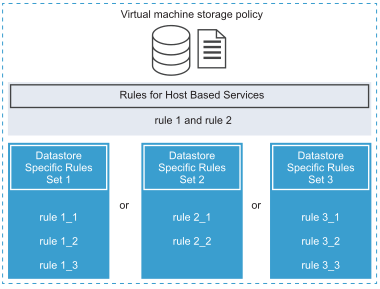After the VM Storage Policies interface is populated with the appropriate data, you can start creating your vSphere storage policies. Creating a policy involves defining specific storage placement rules and rules to configure data services.
- Rules
- The rule is a basic element of the VM storage policy. Each individual rule is a statement that describes a single requirement for virtual machine storage and data services.
- Rule Sets
- Within a storage policy, individual rules are organized into collections of rules, or rule sets. Typically, the rule sets can be in one of the following categories: rules for host-based services and datastore-specific rules.
- Datastore-Specific Rule Sets
- Each rule set must include placement rules that describe requirements for virtual machine storage resources. All placement rules within a single rule set represent a single storage entity. These rules can be based on storage capabilities or tags.
- Placement Rules: Capability-Based
- Placement rules specify a particular storage requirement for the VM and enable SPBM to distinguish compatible datastores among all datastores in the inventory. These rules also describe how the virtual machine storage objects are allocated within the datastore to receive the required level of service. For example, the rules can list Virtual Volumes as a destination and define the maximum recovery point objective (RPO) for the Virtual Volumes objects.
- Placement Rules: Tag-Based
- Tag-based rules reference datastore tags. These rules can define the VM placement, for example, request as a target all datastores with the VMFS-Gold tag. You can also use the tag-based rules to fine-tune your VM placement request further. For example, exclude datastores with the Palo Alto tag from the list of your Virtual Volumes datastores. See Create a VM Storage Policy for Tag-Based Placement.
- Rules for Host-Based Services
- This rule set activates data services provided by the host. The set for host-based services can include rules or storage policy components that describe particular data services, such as encryption or replication.
| Rules for Host-Based Services | Datastore-Specific Rule Sets |
|---|---|
| Rules or predefined storage policy components to activate data services installed on ESXi hosts. For example, replication by I/O filters. | Capability-based or tag-based placement rules that describe requirements for virtual machine storage resources. For example, Virtual Volumes placement. |
| Rules or predefined storage policy components that activate data services provided by storage. For example, caching by Virtual Volumes. |
Relationships Between Rules and Rule Sets
The boolean operator OR defines the relationship between the datastore-specific rule sets within the policy. The AND operator defines the relationship between all rules within a single rule set. The policy can contain only a rule set for host-based services, or only a datastore-specific rule set, or both.
If the rule set for host-based services is not present, meeting all the rules of a single datastore-specific rule set is sufficient to satisfy the entire policy. If the rule set for host-based services is present, the policy matches the datastore that satisfies the host services rules and all rules in one of the datastore-specific sets.
